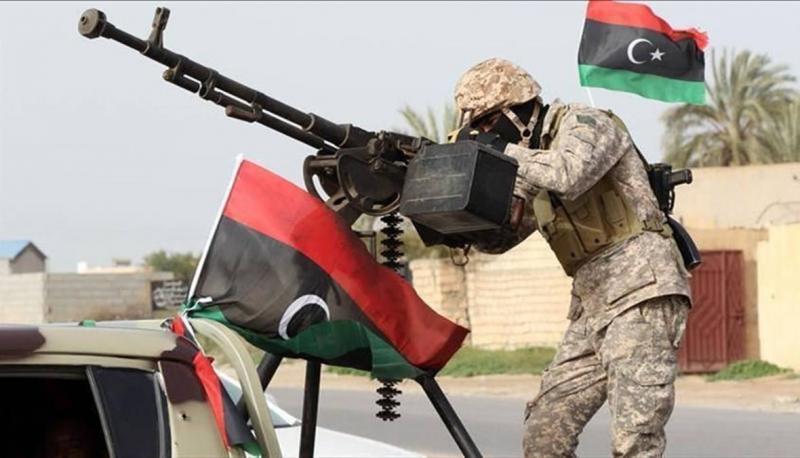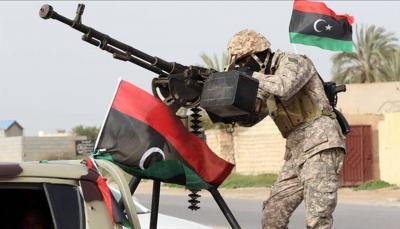Competing armed factions in Tripoli engaged in battle following news of the arrest of a military leader earlier this August, leading to an escalation of clashes in Libya, marking the worst fighting this year. Since the 2011 uprising, which was supported by NATO, Libya has experienced little peace or security, and it has been divided between warring factions in the east and west since 2014. What are the key events during the years of chaos and division in Libya?
**2011 - Revolution and Civil War**
The spark of an uprising against Muammar Gaddafi's four-decade rule spread quickly, igniting an armed revolution supported by NATO airstrikes. Gaddafi was overthrown in August and killed in October.
**2012 - Armed Groups Solidify Their Presence**
A council of opposition members held a vote to elect a National Congress temporarily to form a transitional government, but actual power remained in the hands of a group of local armed factions. Islamist militants attacked the U.S. consulate in Benghazi, resulting in the death of the then-American ambassador.
**2013 - Increasing Divisions**
The power of armed groups intensified, surrounding government buildings and forcing the National Congress to yield to their demands. Egypt, having overthrown its Muslim Brotherhood government, grew increasingly concerned about extremist groups in Libya.
**2014 - Division Between the East and West**
Retired General Khalifa Haftar established the Libyan National Army in eastern Libya, fighting against the Islamist armed factions. The National Congress rejected the results of the new parliament elections, the House of Representatives, and formed a government backed by armed groups in the west. Supported by Haftar, the newly elected parliament then moved from Tripoli to the east to support the previous transitional government. Libya became divided between competing administrations in the east and west.
**2015 - Islamists Advance**
Islamic groups exploited the chaos, with ISIS taking control of the city of Sirte in February. The militants also controlled large parts of Benghazi and Derna. In December, the two competing parliamentary bodies signed the "Libyan Political Agreement" to establish a new transitional process under a Government of National Unity. The agreement confirmed that the House of Representatives was the Libyan parliament but gave members of the National Congress a new advisory role as the High State Council. This agreement laid the groundwork for diplomatic efforts in the years to come. Despite this, the division persisted in the east and west.
**2016 - The Decline of ISIS**
Despite the Libyan Political Agreement, the House of Representatives rejected the new government taking power in Tripoli, entrenching the division between the east and west of Libya. Ultimately, armed factions in the west retook the city of Sirte from ISIS, while Haftar fought the militants in Derna and Benghazi and took control of the energy-producing "oil crescent" region in central Libya.
**2017-2018 - Deepening Chaos**
Fighting intensified as armed groups in the west battled for control of Tripoli while the Libyan National Army in the east and other key factions fought the Islamic extremist groups across the country. New peace efforts soon collapsed.
**2019 - Haftar Attacks Tripoli**
After defeating the Islamic groups in the east, Haftar led his forces south of Libya, seizing most of the remaining oil fields. In April, on the day the UN Secretary-General arrived in Tripoli for peace talks, Haftar launched a surprise attack to take control of the capital. The assault was backed by the UAE, Egypt, and Russia. The Libyan armed groups in the west united to support the Tripoli government with assistance from Turkey.
**2020 - Ceasefire**
Turkey openly sent its forces to support Tripoli, leading to the collapse of Haftar's offensive. With the retreat of his forces, evidence of atrocities committed in the town of Tarhuna was discovered. Both sides agreed to a formal ceasefire, and the UN called on Libyan politicians and civil society to convene in Tunisia in new efforts aimed at holding national elections the following year.
**2021 - Failed Electoral Process**
All factions in the east and west agreed to form a new Government of National Unity aimed at overseeing elections in December. However, the House of Representatives in the east and the High State Council in the west could not agree on a new constitution or voting rules, leading to the collapse of the elections at the last minute.
**2022 - Standoff**
The two parliamentary bodies stated that the unity government had lost its legitimacy, but the prime minister refused to resign. The House of Representatives appointed a rival administration in eastern Libya, but it failed to enter Tripoli, resulting in the continued control of the unity government and an ongoing political standoff without resolution.
**2023 - Paralyzed State**
An unstable, fragile peace prevailed in Libya. However, behind the scenes, political maneuvering continued among the factions, and the standoff persisted. Diplomacy focused on UN efforts to advance the date of elections, but many in Libya remained skeptical that their leaders were comfortable with the lack of elections that could remove them from power.




